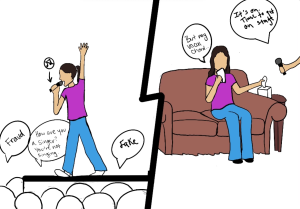Lip-Syncing Is Not an Egregious Crime
April 18, 2023
“Mariah Carey’s Disastrous Performance on New Year’s Eve 2016.”
“Selena Gomez Slammed for 2017 AMA Performance.”
These are just two of the thousands of degrading headlines criticizing renowned vocalists for lip-syncing on stage. Instead of receiving appreciation for their spectacular performance, many talented artists face severe backlash for using a pre-recorded track rather than singing live.
Despite the numerous complaints from dissatisfied audience members, lip-syncing to a pre-recorded track during concerts allows singers to effectively meet the demands of their fans while avoiding long-term vocal cord damage. Artists are not dishonest for taking measures to protect their health and preserve their overworked voices.
Concert-goers often underestimate the detrimental effects that continuous live singing has on a performer’s voice. Hectic practice schedules coupled with extended tour performances take a toll on an artist’s voice and permanently damage fragile vocal cords.
“The strain of singing full-voiced for an hour and a half is intense — as hard on the larynx as a professional football game is on a lineman’s body,” Dr. Natasha Mirza, the director of the Center for Voice and Swallowing at the University of Pennsylvania, said in an interview with the New York Times.
Without relying on pre-recorded tracks, artists do not have sufficient time to recover between shows and must endure vocal fatigue.
Overworking the voice catalyzes the development of polyps, cysts, granulomas and nodules on their vocal folds, according to the Cleveland Clinic. These growths prevent the vocal cords from vibrating normally, causing hoarseness, vocal cracks and neck pain, according to CBS News.
As a result, acclaimed artists who are praised for their live vocals like Adele, Keith Urban and John Mayer require surgery to remove growths. Suffering from a severe case of vocal nodules, Adele underwent laser surgery for her throat and was forced to cancel shows for over half a year, according to The Guardian.
While these artists received positive responses for steering away from lip-syncing, their efforts to sing live cost them their laryngeal health and jeopardized their singing careers.
For many concert-goers who have listened to the same songs many times before, the highlight of a show is not the auditory elements, but rather the visual appeal.
Artists often incorporate choreography and precise stage blocking to keep fans entertained. Consequently, lip-syncing allows artists to maintain their high energy and engage in strenuous on-stage activities like dancing and jumping as they sing.
“I don’t know any athlete in the world who can do that for more than an hour and not become winded,” Jack Boessneck, vice president of one of the largest sound equipment rental houses Eighth Day Sound, said in an interview with the Hollywood Reporter. “That’s why there’s a simultrack [pre-recorded track] running. If an artist happens to not be able to hit the notes, that backing track helps. That’s only fair.”
Regardless of whether the performance is live or lip-synced, concert-goers should take the time to celebrate the stagecraft of the artists and enjoy the extravaganza unfolding in front of their eyes.




